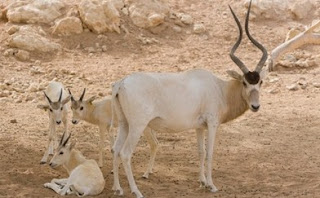Addax (Addax nasomaculatus), also known as a screw deer horn, is an endangered species of deer that live in the Sahara desert. As suggested by the name of an alternative, this antelope has a long pale, curved horns. It is closely related to the oryx, but differs from other antelopes by having large square teeth like a cattle and lacking the typical facial glands. Although extremely rare in its native habitat because hunting is not regulated, it is very common in captivity. They are sometimes hunted as trophies on farms in the United States.
Addax is primarily herbivores, and adapted to living in water dengankelangkaan large area. These animals can be easily hunted by predators because it is slow. Because of the slow movement, which Addax is a tasty target for predators such as lion, human, African hunting dogs, cheetahs and leopards. Caracals, hyenas and servals calf attacks. Addax do not feel disturbed easily, although orangsering turned aggressive at being disturbed.
It is believed the name "Addax" derived from an Arabic word meaning crooked horn liardengan animals. The word "nasomaculatus" comes from the Latin word "nasus" (atauawalan "naso") which means nose and "macula" which means a place or notice and the suffix - "atus" refers to spots and signs of deer face. Baduimenggunakan another name for Addax, which is the Arabic term "Fuel" (or "bagr") "alWahsh", which literally means cattle from the wild. This name can be used to refer to other ungulates.
Addax inhabits dry areas, semideserts and desert and rocky, but today only found in pairs or as individuals is rare in the Sahara desert danbeberapa neighboring areas. Addax is extinct in Jordan since 1900 and in Mesirdan Morocco in the mid-20th century. This animal once abundant in northern Africa, asliwilayah like Chad, Mauritania and Niger. In 1972, Addax was found especially on the Rio de Oro, Mauritania, northern Mali and Chad, with some in Algeria, LibyaSelatan, and northern Sudan. Rare everywhere except in uninhabited areas in Mauritania and Mali in Western Sahara. It is now found in a rare population in Mauritania, Mali, Chad, Niger and nearly extinct in Sudan, Algeria, Egypt, Libya ArabJamahiriya and Western Sahara. Some Addax can be found on a game farm in Texas where they are bred for hunting trophies. See C.B.S. program "60 Minutes" of 29.01.2012.
 |
| Addax |
In ancient times, Addax occur from North Africa through Arabia and the Levant. Pictures of Egyptian tombs show merekauntuk kept as pets around 2500 BC. More recently, Addaxditemukan from Algeria to Sudan, but mainly because of overhunting, they have become much more limited and rare. Dama gazelle and oryx sword is also found in the same area. It is easy to hunt because gerakanlambat, particularly the use of motor vehicles and automatic weapons. In addition to the meat and the skin is very valuable. Other threats include chronic drought padakehancuran, desert habitat as more human settlements and agriculture. It is believed that fewer than 500 individuals left in the wild today, most hewanyang found between regions Thermite Niger and western Chad Bodele region.
In Israel, Yotvata Hai-Bar Nature Reserve Addax descent to return them to the wild. Although large reserves, such as the Ahaggar National Park and Tasilli in Algeria, Ténéré in Niger, the Ouadi rime-Ouadi Achim in Chad, and Wadibaru established Howar National Park. in Sudan cover the area where the previous Addax happen, some do not keep Addax longer because less resources. Addax has been introduced in Tunisia and Morocco, the first in Bou Hedma National Park (Tunisia).














No comments :
Post a Comment